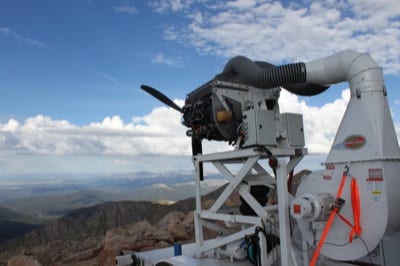NEW RICHMOND, Wis. — Engineered Propulsion Systems reports “significant technical progress” in the development of its new water-cooled Vision 350 flat V, 350-hp diesel engine for general aviation.
Among the milestones achieved recently are the testing and calibration of EPS-designed turbochargers; positive results of heat rejection tests; high altitude (10,000–15,000 ft MSL) operation and re-starts at Lake County Airport and in Mount Evans Colorado, on the company’s mobile test stand; vibration testing with Hartzell aluminum propeller blades; the prototype design/analysis/manufacture of steel pistons; horsepower increases to more than 400 hp; and the prototype design of compacted graphite iron engine crankcase blocks.
Important to the design of the Vision 350 diesel engine is its ability to accept aluminum propellers, according to company officials. Powering a Hartzell aluminum scimitar 78-inch prop, the EPS diesel produced very low vibration throughout its full RPM range, officials noted.
 The heat rejection tests are necessary to optimize radiator and intercooler size while minimizing coolant drag, company officials explained. Heat rejection from compression ignition in diesel engines is less significant than gasoline engines due to the inherent efficiency of the diesel, but must be carefully controlled and dissipated to enhance reliability, officials add.
The heat rejection tests are necessary to optimize radiator and intercooler size while minimizing coolant drag, company officials explained. Heat rejection from compression ignition in diesel engines is less significant than gasoline engines due to the inherent efficiency of the diesel, but must be carefully controlled and dissipated to enhance reliability, officials add.
“The compression ratio in the Vision 350 is 17:1, which is partially responsible for its thermal efficiency; along with enhanced combustion made possible with an electronic engine management system, injection hardware and strategies from Bosch General Aviation Technology,” officials said in a prepared release.
The development of steel pistons will allow increased takeoff horsepower from the twin-turbocharged powerplant. Additional engine strength is provided through the use of engine block halves of high-strength compacted graphite iron, according to company officials.
“Every step we take in development of this engine is deliberate and without undue haste,’’ says Steven Weinzierl, EPS vice-president and chief technology officer. “We want to make sure we progress, not regress, along the path to certification. Recent success in high-altitude cold starts (15,300 density altitude) is our latest technological milestone performed by the company’s static test bed article near the summit of Mount Evans, Colorado.”
The flat V design of the 4.4 litre engine allows installation on more airframes than a typical 90° V8, ensuring low profile, low drag applications. The engine is more suitable for twin-engine applications than other engine configurations, with its low frontal area, increased propeller/ground clearance, and compact design, company officials note.
“Our Vision 350 is new from the ground up,” Michael Fuchs, EPS president/CEO added. “The aero-engine industry has been resting on 60-year-old design technology; we think we offer a new and viable alternative in our horsepower range for many airframe types and configurations. And being a diesel, fuel will be more available internationally, whether it is pure kerosene or Jet A. Right now, fuel efficiency is proving out at nearly 30-50% better than six-cylinder avgas engines.”
He noted that the engine’s best specific fuel consumption (SFC) approximates lower than 0.32 lb/hp/hr. A typical TIO-540 gasoline (Avgas) engine has a SFC of approximately 0.42 lb/hp/hr, he added.
“While the weight of the Vision 350 will prove out at between 30 and 50 pounds greater than a typical turbocharged six-cylinder avgas engine, the fuel efficiency more than compensates for that difference,” he said. “We are seeing fuel flows of under 11 GPH at 65% power.”
The twin-turbocharged Vision 350 is the first to test an aircraft engine on Mount Evans using a mobile test laboratory. The Liberty V-12 tested its turbocharging program in 1918 on Pike’s Peak in a similar fashion.
EPS will be displaying its Vision 350 diesel at AirVenture 2013 in Oshkosh, Wisconsin, from July 29-Aug. 4, at Innovations Pavilion, booth #9.
For more information: EPS.aero

Will your engine work in a 421C and what is a reasonable timeline for certification?